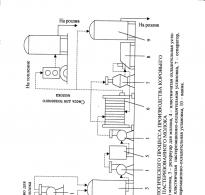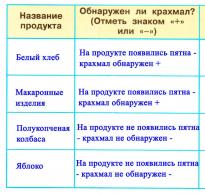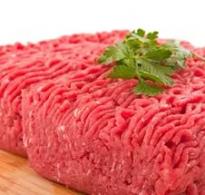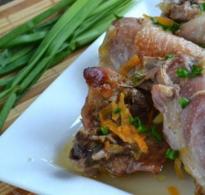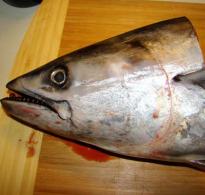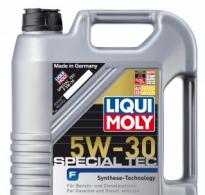A variety of substances in the surrounding world. Lesson "Variety of substances" outline of a lesson on the outside world (grade 3) on the topic
1. Our inquisitive Parrot has compiled a crossword puzzle for you. Solve it, and you will be convinced that you know not so little about substances.
Horizontally:
1. Substance of which lakes, rivers, seas are composed (water)
.
2. A substance that is in sweets and chocolates (sugar)
.
3. Substances with a sour taste (acid)
.
4. Grape sugar (glucose)
.
Vertically:
1. Substance that can be used to wash dishes, gargle; it is also added to the dough (soda)
.
2. Substance from which wire and some utensils are made (aluminum).
3. The substance of which the nail is composed (iron)
.
4. Substance, which is a lot in potatoes and jelly (starch)
.
5. A substance that we always see on the dinner table, but never add to tea (salt).
2. Practical work "We investigate products for starch content".
Objective: determine if starch is present in the tested foods.
Equipment: products provided by the teacher; diluted tincture of iodine, pipette.
Progress:
- Conduct experiments: Using a pipette, apply a drop of iodine tincture to each of the test products.
- Fill out the table as you work.

Assessment of the work performed(is the goal achieved): the goal was achieved, now I can easily find out which products contain starch and which do not.
Presentation: report your progress to the class, listen to and evaluate other messages.
For practical work, I prepared the following equipment: a jar of iodine, a dropper, a plate, a phone with a camera, a slice of bread, pasta, a few slices of half-smoked sausage and an apple cut into slices.
Having laid out the products on a plate, I dropped a drop of iodine on each of them from a pipette. The results were not long in coming. Dark blue spots from iodine instantly appeared on the bread and on the “macaroshka”. But the sausage and apple remained unchanged.
Then I photographed each product for the table in the experiment.
Conclusion: a lot of starch is found in bread and pasta, but there is no iodine in semi-smoked sausage and apples.
A variety of substances or "How Pigtail was a sorceress" An integrated lesson in the surrounding world and chemistry. Hey! My name is Kisichka! I am in grade 3 and go to school every day. At school I am always interested. But there are classes where I haven’t been! Today we will go on a short trip: we will try to "look" into some office! For example: "H-I-M-I-I" ... And what is "chemistry"? Chemistry is the science of substances. There are many different substances in the world. Remember what we talked about in the last lesson! In the last lesson of the world around us, we learned new concepts: Bodies of Substance Particles Pigtail! Today you will learn new things about some substances, but first, I suggest you become a "sorceress" for a while! Together we will show amazing chemical "experiments"! Now, let's see what lies in front of you on the desk? Separately - I'm not so tasty, But in food - everyone needs it. What do you know about salt? Salt is a white substance, it looks like grains. But in nature, salt can also be found in the form of a stone, or it can be contained in sea water. Salt - dissolves well in water, giving it a salty taste. Look at the next plate! He is white as snow, prickly. Like dry, free-flowing sand. Sweet, sweet like honey A fly often drinks tea with him ... We meet sugar every day! It looks very much like salt! But not to your taste! And sugar is obtained from sugar cane or sugar beet. Though, like powder, Delicate, white, And not sugar And not chalk. It turns into jelly From year to year Turns us Compote. Starch. Starch is found in many plant foods. Do you want to do the "magic" again? I suggest you conduct a series of experiments! Let's try to find out: which foods contain starch! For this we use a diluted tincture of iodine. If the product contains starch, then when iodine drops get on it, it will turn blue-violet. Let's draw a conclusion! Starch is found in: White bread Potatoes Acid. A large group of substances are acids. Acids are found in lemon, apples, sorrel leaves. A person uses many acids in the kitchen. But be careful! Our lesson is coming to an end! Pigtails' "magical journey" is also coming to an end! However, don't be upset! Remember, Pigtail! Every time mom starts baking a pie in the kitchen, you will again meet your "familiar" substances SUGAR, SALT, STARCH, ACID. But now you can already tell a lot of interesting things about them! THE END. This presentation was created for an integrated lesson in chemistry and environment. of the world according to the textbook of A.A. Pleshakov "The world around us" Authors of the presentation - Yudaicheva ON. and Serzhantova M.A.
Variety of substances
Presentation for a lesson in the world around us in grade 3
Prepared by: Kamalova Zugra Avalovna
primary school teacher
MBOU SOSH s. Caramal


SALT
- Separately, I am not so tasty, but everyone needs food

Salt
Table salt is one of the naturally occurring mineral salts. For humans, salt is vital. If it is not enough for a long time, a person may die. In ancient times, salt was literally worth its weight in gold. Those times have passed, now salt is mined in sufficient quantities. And the reserves of salt on Earth are truly inexhaustible. There are whole salt mountains in the bowels of the Earth and on its surface. In a dissolved state, salt is found in the water of the seas and oceans.

Salt in nature
Sea salt

I'm white as snow
In honor of everyone
I got into my mouth -
There he disappeared.

Sugar
You have been familiar with this substance all your life. Its main property is sweet taste.

- . There was a time when people in Russia did not even know about sugar. Honey, sweet sap of birch, linden, maple were used.
- The sweet cane syrup was made in India. Sugar was a very expensive curiosity. We have been looking for a replacement for sugar cane for a long time. They offered so many things: cabbage, pumpkin, corn, but the problem is that there is not enough sugar in them. Sugar beet won. At the beginning of the 19th century, the first factories were built in Russia and Germany, which began to make sugar from sugar beets.




Glucose
There is also a sweet substance in nature: glucose. This is a type of sugar. In nature, it is found in various parts of plants. The fruits of grapes and grape juice are especially rich in glucose.

- - White powder is starch. It is used when jelly is boiled. It is found in many plant foods.

- – Acid Is a large group of substances that we encounter in the kitchen. Everyone knows the sour taste of lemon. Citric acid gives it this taste. In apples - malic acid, in sorrel - oxalic acid.
- Acids in the kitchen must be handled very carefully. Especially with acetic acid. Do not touch the bottle with this acid.

- What are the main properties of table salt and sugar? Where do these substances occur in nature?
- What is starch? How is it found in food?
- What acids are found in nature?
- What is the common property of these substances?
- Why do acids need to be handled with care? Can any acid taste be tasted?
- What is acid rain? What is their danger?
1. Our inquisitive Parrot has compiled a crossword puzzle for you. Solve it, and you will be convinced that you know not so little about substances.
Horizontally:
1. Substance of which lakes, rivers, seas are composed (water)
.
2. A substance that is in sweets and chocolates (sugar)
.
3. Substances with a sour taste (acid)
.
4. Grape sugar (glucose)
.
Vertically:
1. Substance that can be used to wash dishes, gargle; it is also added to the dough (soda)
.
2. Substance from which wire and some utensils are made (aluminum).
3. The substance of which the nail is composed (iron)
.
4. Substance, which is a lot in potatoes and jelly (starch)
.
5. A substance that we always see on the dinner table, but never add to tea (salt).
2. Practical work "We investigate products for starch content".
Objective: determine if starch is present in the tested foods.
Equipment: products provided by the teacher; diluted tincture of iodine, pipette.
Progress:
- Conduct experiments: Using a pipette, apply a drop of iodine tincture to each of the test products.
- Fill out the table as you work.

Assessment of the work performed(is the goal achieved): the goal was achieved, now I can easily find out which products contain starch and which do not.
Presentation: report your progress to the class, listen to and evaluate other messages.
For practical work, I prepared the following equipment: a jar of iodine, a dropper, a plate, a phone with a camera, a slice of bread, pasta, a few slices of half-smoked sausage and an apple cut into slices.
Having laid out the products on a plate, I dropped a drop of iodine on each of them from a pipette. The results were not long in coming. Dark blue spots from iodine instantly appeared on the bread and on the “macaroshka”. But the sausage and apple remained unchanged.
Then I photographed each product for the table in the experiment.
Conclusion: a lot of starch is found in bread and pasta, but there is no iodine in semi-smoked sausage and apples.
Class: 3
Lesson type. Discovery of new knowledge.
Subject results. Third-graders will learn what substances are, what properties they have and how they are used by humans.
Metasubject results.
Cognitive UUD. Ability to navigate in your knowledge system, gain new knowledge, find answers to questions using your life experience and information gained in the lesson.
Regulatory UUD. Determine and formulate the goal of your activities at each stage of the lesson, articulate your actions in a logical sequence, learn to self-assess your activities in the lesson.
Communicative UUD. The ability to formulate their thoughts orally, listen and understand the speech of others, the willingness to listen to the interlocutor, the ability to work in a group, in pairs.
Necessary equipment: PC, interactive whiteboard, A. Pleshakov. The world around us. 3 class. Textbook. for educational institutions. Part 1.M. Education. 2012, Workbook. A. A. Pleshakov. The world. Grade 3. Part 1.
Salt, sugar, citric acid, vinegar, potatoes, pears, apples, bread, diluted iodine tincture, pipette.
During the classes
I. Attention. Forecasters are working. Working with the observation diary.
Look out the window. What day: sunny, cloudy? Let's mark it in the diary. Direction of the wind. Let's look at the thermometer. What temperature does it show? Let's note. Is there any precipitation? What else can you say about the weather today? What is the forecast for tomorrow?
II. Knowledge update.
Children answer the test questions on the topic “Bodies, Substances, Particles”. ( Annex 1)
Conclusion. Any object, any living being can be called a body. Bodies are made of substances. Substances consist of the smallest particles not visible to the eye.
III. Motivation for learning activities.
- And now let's listen to A. Karpov's poem “At Mom's Kitchen”. ( Appendix 2)
- Where are we going with you? (To mom in the kitchen.)
- Let's see what substances are in each of us at home.
IV. Work on the topic of the lesson.
The teacher puts several transparent jars on the table, which contain salt, sugar, starch, citric acid.
- Can you determine: what substances are in the jars? What needs to be done for this?
- What substance is the riddle about?
They don't eat me alone, but they don't eat anything without me either.
This is salt. It is necessary for the normal functioning of the body. Salt is found in all parts of the body and is essential for building the skeleton.
Hear ancient salt legends. ( Appendix 3).
- Salt used to be very expensive. People did not know how to get it. In some countries there was money made from salt. Any purchase could be paid for with lumps of salt. Then it turned out that the reserves of salt in nature are enormous. They began to extract it in large quantities. Salt has become the cheapest product. In salt lakes and seas there are huge reserves of salt. Salt was mined from the bottom of dried up lakes. Where the lakes dried up, the salt was covered with sand and earth. Land and sometimes mountains were formed. Under this weight, the salt thickened and became as hard as a stone. Therefore, they began to call it rock salt. To get to this salt, they dig deep mines.
- In the kitchen, you will definitely come across another white substance. Guess?
I am white as snow, in honor of everyone, I got into my mouth, and there I disappeared.
- It's sugar. Previously, people in Russia did not know about sugar. People used honey.
Trained students talk about sugar. ( Appendix 4).
- Sugar is not the only sweet substance in nature.
Where else can you find sugar? Let's read about it in the tutorial.
- From which country did the reed "move" to different countries?
- Why is this plant not grown in our country?
- What is the source of sugar in Russia?
- What is glucose?
- Where is it found in nature?
- What else can you call glucose?
There is another white substance that can be found in the kitchen. It's starch.
- Do you know foods that contain starch?
Practical work.
- Now we will try to determine: which products contain starch, and which do not.
Group work.
Each group receives sliced potatoes, apples, pears, and bread.
- Conduct the experiment: using a pipette, apply a drop of iodine to each of the test products. Fill out the table as you work.
The results are recorded in a workbook. Assessment of the work performed.
The last substance in Mom's kitchen is citric acid.
- How many knows why she is in the kitchen? Read the textbook about what other foods contain acids. Children read the article on pages 43-44.
- What foods contain acid?
- What is the common property of these substances?
- How should they be treated?
- Where are acids in the environment?
Work in pairs.
Tasks of the textbook p.44. Description of the substance according to the plan.
V. Reflection of educational activities.
The guys answer the questions of the "Check yourself" section on p. 45.
- What should we have learned in the lesson? What to learn?
Vi. Homework.
The Curious Parrot offers you a crossword puzzle in the workbook on page 25 and homework assignments in the textbook on page 45.

